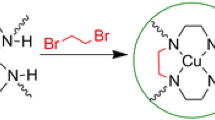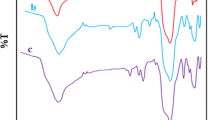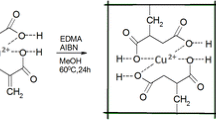Abstract
In this study, Cu(II)-ion-imprinted membrane adsorbents were prepared via cross-linking of blended chitosan/poly(vinyl alcohol) using glutaraldehyde as cross-linker and copper ions as template. The ability of IIMs to adsorb copper ions from aqueous solutions was assessed using a batch of experiments under different conditions by changing cross-linking density (0.05 mass %, 0.1 mass %, and 0.2 mass %), template content (0.2 mass %, 0.5 mass %, and 0.9 mass %), initial analyte concentration (50 mg L−1, 100 mg L−1, and 150 mg L−1), and adsorbent concentration (0.5 g L−1, 1.0 g L−1, and 2.0 g L−1). The Taguchi method was used to plan a minimum number of experiments. The following optimal levels were thus determined for the four factors: cross-linking density: 0.1 mass %; template content: 0.5 mass %; initial analyte concentration: 150 mg L−1; and adsorbent concentration: 0.3 g L−1.
Similar content being viewed by others
References
Beppu, M., Arruda, E. J., Vieira, R. S., & Santos, N. N. (2004). Adsorption of Cu(II) on porous chitosan membranes functionalized with histidine. Journal of Membrane Science, 240, 227–235. DOI: 10.1016/j.memsci.2004.04.025.
Bogya, E. S., Barabás, R., Csavdári, C., Dejeu, V., & Bâldea, I. (2009). Hydroxyapatite modified with silica used for sorption of copper(II). Chemical Papers, 63, 568–573. DOI: 10.2478/s11696-009-0059-x.
Borneman, Z. (2007). Particle loaded membrane chromatography. Ph.D. thesis, University of Twente, Twente: The Netherlands.
Bulgariu, L., Bulgariu, D., & Macoveanu, M. (2012). Characteristics of sorption of uncomplexed and complexed Pb(II) from aqueous solutions onto peat. Chemical Papers, 66, 239–247. DOI: 10.2478/s11696-012-0149-z.
Cao, J., Tan, Y. B., Che, Y. J., & Xin, H. P. (2010). Novel complex gel beads composed of hydrolyzed polyacrylamide and chitosan: An effective adsorbent for the removal of heavy metal from aqueous solution. Bioresource Technology, 101, 2558–2561. DOI: 10.1016/j.biortech.2009.10.069.
Chen, A. H., Yang, C. Y., Chen, C. Y., Chen, C. Y., & Chen, C. W. (2009). The chemically crosslinked metal-complexed chitosans for comparative adsorptions of Cu(II), Zn(II), Ni(II) and Pb(II) ions in aqueous medium. Journal of Hazardous Materials, 163, 1068–1075. DOI: 10.1016/j.jhazmat.2008.07.073.
Chen, J. H., Li, G. P., Liu, Q. L., Ni, J. C., Wu, W. B., & Lin, J. M. (2010). Cr(III) ionic imprinted polyvinyl alcohol/sodium alginate (PVA/SA) porous composite membranes for selective adsorption of Cr(III) ions. Chemical Engineering Journal, 165, 465–473. DOI: 10.1016/j.cej.2010.09.034.
Chen, J. H., Lin, H., Luo, Z. H., He, Y. S., & Li, G. P. (2011). Cu(II)-imprinted porous film adsorbent Cu-PVA-SA has high uptake capacity for removal of Cu(II) ions from aqueous solution. Desalination, 277, 265–273. DOI: 10.1016/j.desal.2011.04.040.
Ghaee, A., Shariaty-Niassar, M., Barzin, J., & Matsuura, T. (2010). Effects of chitosan membrane morphology on copper ion adsorption. Chemical Engineering Journal, 165, 46–55. DOI: 10.1016/j.cej.2010.08.051.
Guibal, E. (2004). Interactions of metal ions with chitosanbased sorbents: a review. Separation and Purification Technology, 38, 43–74. DOI: 10.1016/j.seppur.2003.10.004.
Koyano, T., Koshizaki, N., Umehara, H., Nagura, M., & Minoura, N. (2000). Surface states of PVA/chitosan blended hydrogels. Polymer, 41, 4461–4465. DOI: 10.1016/s0032-3861(99)00675-8.
Lépinay, S., Kham, K., Millot, M. C., & Carbonnier, B. (2012). In-situ polymerized molecularly imprinted polymeric thin films used as sensing layers in surface plasmon resonance sensors: Mini-review focused on 2010-2011. Chemical Papers, 66, 340–351. DOI: 10.2478/s11696-012-0134-6.
Li, N., & Bai, R. (2005). Copper adsorption on chitosan-cellulose hydrogel beads: behaviors and mechanisms. Separation and Purification Technology, 42, 237–247. DOI: 10.1016/j.seppur.2004.08.002.
Lufting, J. T., & Jordan, V. S. (1998). Design of experiments in quality engineering. New York, NY, USA: McGraw-Hill.
Mohammadi, T., & Safavi, M. A. (2009). Application of Taguchi method in optimization of desalination by vacuum membrane distillation. Desalination, 249, 83–89. DOI: 10.1016/j.desal.2009.01.017.
Peydayesh, M., Esfandyari, G. R., Mohammadi, T., & Alamdari, E. K. (2013). Pertraction of cadmium and zinc ions using a supported liquid membrane impregnated with different carriers. Chemical Papers, 67, 389–397. DOI: 10.2478/s11696-013-0310-3.
Shawky, H. A. (2009). Synthesis of ion-imprinting chitosan/PVA crosslinked membrane for selective removal of Ag(I). Journal of Applied Polymer Science, 114, 2608–2615. DOI: 10.1002/app.30816.
Tasselli, F., Donato, L., & Drioli, E. (2008). Evaluation of molecularly imprinted membranes based on different acrylic copolymers. Journal of Membrane Science, 320, 167–172. DOI: 10.1016/j.memsci.2008.03.071.
Tofighy, M. A., Shirazi, Y., Mohammadi, T., & Pak, A. (2011). Salty water desalination using carbon nanotubes membrane. Chemical Engineering Journal, 168, 1064–1072. DOI: 10.1016/j.cej.2011.01.086.
Varma, A. J., Deshpande, S. V., & Kennedy, J. F. (2004). Metal complexation by chitosan and its derivatives: a review. Carbohydrate Polymers, 55, 77–93. DOI: 10.1016/j.carbpol.2003.08.005.
Vatanpour, V., Madaeni, S. S., Zinadini, S., & Rajabi, H. R. (2011). Development of ion imprinted technique for designing nickel ion selective membrane. Journal of Membrane Science, 373, 36–42. DOI: 10.1016/j.memsci.2011.02.030.
Vieira, R. S., & Beppu, M. M. (2006). Interaction of natural and crosslinked chitosan membranes with Hg(II) ions. Colloids and Surfaces A: Physicochemical and Engineering Aspects, 279, 196–207. DOI: 10.1016/j.colsurfa.2006.01.026.
Vold, I. M. N., Vårum, K. M., Guibal, E., & Smidsrød, O. (2003). Binding of ions to chitosan-selectivity studies. Carbohydrate Polymers, 54, 471–477. DOI: 10.1016/j.carbpol.2003.07.001.
Wan Ngah, W. S., Kamari, A., & Koay, Y. J. (2004). Equilibrium and kinetics studies of adsorption of copper (II) on chitosan and chitosan/PVA beads. International Journal of Biological Macromolecules, 34, 155–161. DOI: 10.1016/j.ijbiomac.2004.03.001.
Wan Ngah, W. S., & Fatinathan, S. (2008). Adsorption of Cu(II) ions in aqueous solution using chitosan beads, chitosan-GLA beads and chitosan-alginate beads. Chemical Engineering Journal, 143, 62–72. DOI: 10.1016/j.cej.2007.12.006.
Wang, X. J., Xu, Z. L., Bing, N. C., & Yang, Z. G. (2008). Preparation and characterization of metal-complex imprinted PVDF hollow fiber membranes. Journal of Applied Polymer Science, 109, 64–73. DOI: 10.1002/app.26805.
Wang, X. W., Zhang, L., Ma, C. L., Song, R. Y., Hou, H. B., & Li, D. L. (2009). Enrichment and separation of silver from waste solutions by metal ion imprinted membrane. Hydrometallurgy, 100, 82–86. DOI: 10.1016/j.hydromet.2009.10.006.
Wang, Z. Q., Wang, M., Wu, G. H., Shen, Y. Y., & He, C. Y. (2010). Ion imprinted sol-gel nanotubes membrane for selective separation of copper ion from aqueous solution. Microchimica Acta, 169, 195–200. DOI: 10.1007/s00604-010-0332-2.
Yan, M., & Ramström, O. (2005). Molecularly imprinted materials: Science and technology. New York, NY, USA: Marcel Dekker.
Zhai, Y. H., Liu, Y. W., Chang, X. J., Ruan, X. F., & Liu, J. L. (2008). Metal ion-small molecule complex imprinted polymer membranes: Preparation and separation characteristics. Reactive and Functional Polymers, 68, 284–291. DOI: 10.1016/j.reactfunctpolym.2007.08.013.
Zhang, L., Yang, S. W., Han, T., Zhong, L. L., Ma, C. L., Zhou, Y. Z., & Han, X. L. (2012). Improvement of Ag(I) adsorption onto chitosan/triethanolamine composite sorbent by an ionimprinted technology. Applied Surface Science, 263, 696–703. DOI: 10.1016/j.apsusc.2012.09.143.
Author information
Authors and Affiliations
Corresponding author
Rights and permissions
About this article
Cite this article
Zarghami, S., Kazemimoghadam, M. & Mohammadi, T. Cu(II) removal enhancement from aqueous solutions using ion-imprinted membrane technique. Chem. Pap. 68, 809–815 (2014). https://doi.org/10.2478/s11696-013-0509-3
Received:
Revised:
Accepted:
Published:
Issue Date:
DOI: https://doi.org/10.2478/s11696-013-0509-3




